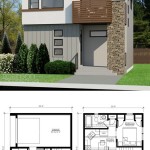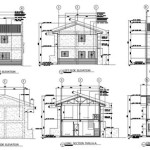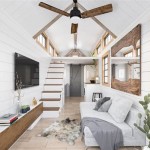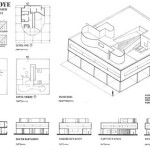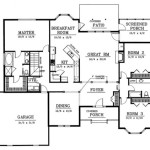Tudor House Plans: A Journey Back in Time
Tudor architecture, a captivating style prevalent in England from the late 15th to early 17th centuries, continues to inspire modern home designs. Characterized by a unique blend of medieval and Renaissance influences, Tudor house plans offer a timeless appeal for those seeking a home with historical charm and distinctive architectural features.
Key Features of Tudor House Plans
Several key elements define Tudor house plans, setting them apart from other architectural styles. These distinctive features contribute to the overall aesthetic and create a sense of grandeur and historical significance. Understanding these elements is crucial for appreciating the essence of Tudor architecture.
*
Steeply Pitched Roofs:
Perhaps the most recognizable feature of Tudor homes is the steeply pitched roofline, often adorned with multiple gables and cross-gables. This dramatic roofline creates a sense of height and adds to the overall imposing presence of the house. *Decorative Half-Timbering:
Half-timbering, a construction technique where exposed timber frames are infilled with stucco or brick, is another hallmark of Tudor architecture. This decorative element adds visual interest and texture to the exterior walls. *Prominent Chimneys:
Large, ornate chimneys are integral to the Tudor aesthetic. These chimneys were not just functional but served as decorative elements, often embellished with elaborate brickwork or stone detailing. *Multi-Paned Windows:
Small, multi-paned windows, frequently casement or diamond-shaped, are characteristic of Tudor homes. These windows contribute to the overall historical ambiance and allow for ample natural light.Exterior Design Elements
The exterior of a Tudor home is carefully designed to create a sense of timeless elegance and historical authenticity. The interplay of materials, textures, and architectural details contributes to the overall visual appeal and establishes a strong connection to the past.
*
Stone and Brick Accents:
Stone and brick are often incorporated into the exterior design, adding to the home’s solidity and visual appeal. These materials can be used for foundation walls, chimneys, or decorative accents around windows and doors. *Arched Doorways and Entries:
Grand arched doorways and entries, often featuring intricate carvings or decorative molding, create a welcoming and impressive entrance. *Bay Windows and Oriel Windows:
Bay windows and oriel windows, projecting outward from the main walls, add architectural interest and enhance the interior space.Interior Layout and Design
Tudor house plans traditionally incorporate specific interior layouts and design elements that reflect the lifestyle and needs of the era. These features contribute to the overall sense of historical authenticity and create a unique living experience.
*
Great Hall:
A central great hall, often featuring a large fireplace and high ceilings, serves as the heart of the home, providing a gathering space for family and guests. *Formal Dining Room:
A separate, formal dining room is another common feature in Tudor homes, reflecting the importance placed on entertaining and social gatherings. *Private Chambers and Studies:
Private chambers and studies offer secluded spaces for relaxation and intellectual pursuits, reflecting the value placed on privacy and individual pursuits.Modern Adaptations of Tudor House Plans
While maintaining the core elements of Tudor architecture, modern adaptations often incorporate contemporary amenities and features to meet the needs of modern living. This blending of old and new creates a unique and appealing home design.
*
Open Floor Plans:
Modern Tudor house plans often incorporate open floor plans, connecting the kitchen, dining, and living areas to create a more spacious and functional living space. *Updated Kitchens and Bathrooms:
Modern kitchens and bathrooms, equipped with contemporary appliances and fixtures, seamlessly blend with the traditional aesthetic, offering both style and functionality. *Energy-Efficient Features:
The incorporation of energy-efficient features, such as insulated windows and improved insulation, allows homeowners to enjoy the charm of a Tudor home while minimizing energy consumption.Choosing the Right Tudor House Plan
Selecting the right Tudor house plan requires careful consideration of various factors, including lot size, lifestyle, and budget. A thoughtful approach ensures that the chosen plan aligns with individual needs and preferences.
*
Lot Size and Orientation:
The chosen plan should be compatible with the available lot size and orientation to maximize the use of space and natural light. *Lifestyle Needs:
The layout and size of the house should reflect the lifestyle needs of the occupants, considering factors such as family size and entertaining habits. *Budget Considerations:
Establishing a realistic budget is crucial to ensure that the chosen plan is financially feasible and aligns with long-term financial goals.Building a Tudor-Style Home
Building a Tudor-style home requires expertise and attention to detail. Collaborating with experienced professionals ensures that the project is completed to the highest standards.
*
Working with an Architect:
Consulting with an architect experienced in Tudor architecture is essential for adapting the chosen plan to the specific site and incorporating desired modifications. *Selecting Qualified Builders:
Choosing qualified and experienced builders specializing in Tudor-style construction is crucial for achieving the desired level of craftsmanship and attention to detail. *Material Selection:
Careful selection of high-quality materials, such as brick, stone, and timber, is essential for ensuring the authenticity and longevity of the finished home.Maintaining a Tudor Home
Maintaining a Tudor home requires ongoing care and attention to preserve its unique architectural features and historical charm.
*
Roof Maintenance:
Regular roof inspections and maintenance are essential to prevent leaks and damage to the intricate roof structure. *Exterior Wall Care:
Proper care of the exterior walls, including cleaning and repair of any damaged stucco or timber, helps to maintain the home's appearance and structural integrity. *Window and Door Upkeep:
Regular maintenance of windows and doors, including painting and repair of any damaged components, ensures their functionality and preserves their historical charm.
Seattle Homes Tudor Style House Plan Design No 132 1908 Western Home Builder Victor W Voorhees

Tudor House Plans Old English Floor

1920 National Plan Service Tudor House Vintage Plans Floor

Plan 020h 0238 The House

Plan 43804 Modern Tudor House

This Is So Perfect Super Attractive Has A Library Though I Probably Won T Be Needing The Servant Tudor House Plans Vintage Cottage

Tudor Style House Plans Floor

Tudor Style House Plans For A Gorgeous Four Bedroom Home

Vintage House Plans 1970s English Style Tudor Homes

Tudor Style House Plan 5 Beds 6 Baths 6475 Sq Ft 413 127 Houseplans Com


